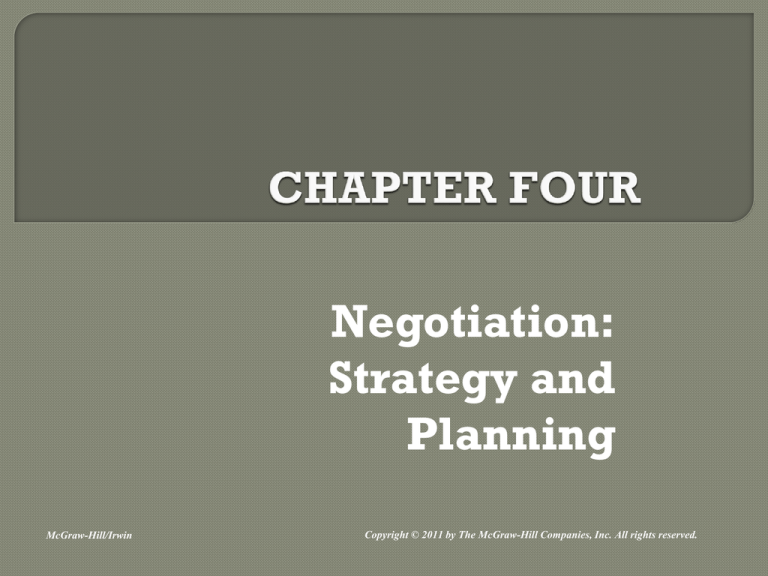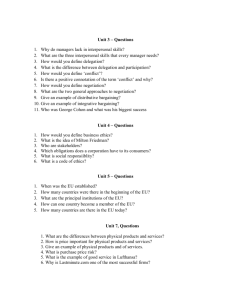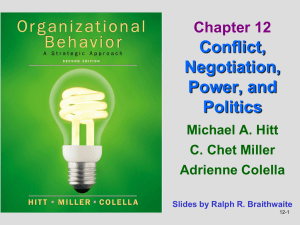
Negotiation:
Strategy and
Planning
McGraw-Hill/Irwin
Copyright © 2011 by The McGraw-Hill Companies, Inc. All rights reserved.
Determining
goals is the first step in
the negotiation process
Negotiators should specify goals and
objectives clearly
The goals set have direct and
indirect effects on the negotiator’s
strategy
4-2
Direct
•
•
•
•
effects
Wishes are not goals
Goals are often linked to the other party’s goals
There are limits to what goals can be
Effective goals must be concrete/specific
Indirect
effects
• Forging an ongoing relationship
4-3
Strategy:
The overall plan to achieve one’s
goals in a negotiation
Tactics: Short-term, adaptive moves
designed to enact or pursue broad
strategies
• Tactics are subordinate to strategy
• Tactics are driven by strategy
Planning:
The “action” component of the
strategy process; i.e. how will I implement
the strategy?
4-4
Unilateral: One
that is made without
active involvement of the other party
Bilateral: One that considers the impact
of the other’s strategy on one’s own
4-5
Avoidance: Don’t negotiate
Competition: I gain, ignore relationship
Collaboration: I gain, you gain, enhance relationship
Accommodation: I let you win, enhance relationship
4-6
Per
the Dual Concerns Model, choice of
strategy is reflected in the answers to two
questions:
• How much concern do I have in achieving my
desired outcomes at stake in the negotiation?
• How much concern do I have for the current and
future quality of the relationship with the other
party?
4-7
If
one is able to meet one’s needs without
negotiating at all, it may make sense to
use an avoidance strategy
It simply may not be worth the time and
effort to negotiate
The decision to negotiate is closely
related to the desirability of available
alternatives
4-8
Competition
– distributive, win-lose
bargaining
Collaboration – integrative, win-win
negotiation
Accommodation – involves an imbalance
of outcomes (“I lose, you win”)
4-9
410
Preparation
• What are the goals?
• How will I work with the other party?
Relationship
building
• Understanding differences and similarities
• Building commitment toward a mutually beneficial
set of outcomes
Information
gathering
• Learn what you need to know about the issues
411
Information
using
• Assemble your case
Bidding
• Each party states their “opening offer”
• Each party engages in “give and take”
Closing
the deal
• Build commitment
Implementing
the agreement
412
Define
the issues
Assemble the issues and define the
bargaining mix
• The bargaining mix is the combined list of issues
Define
your interests
• Why you want what you want
413
Know
your limits and alternatives
Set your objectives (targets) and opening
bids (where to start)
• Target is the outcome realistically expected
• Opening is the best that can be achieved
Assess
constituents and the social context
of the negotiation
414
415
Analyze
the other party
• Why do they want what they want?
• How can I present my case clearly and refute the
other party’s arguments?
Present
the issues to the other party
416
Resources, issues, and
Interests
bargaining mix
and needs
Walkaway point and alternative(s)
Targets and opening bids
Constituents, social structure, and
authority to make an agreement
Reputation and negotiation style
Likely strategy and tactics
417
Define
the protocol to be followed in the
negotiation
•
•
•
•
•
•
•
What is the agenda?
Who will be there?
Where will the negotiation occur?
What is the time period?
What might be done if the negotiation fails?
How will we keep track of what is agreed to?
How do we know whether we have a good
agreement?
418
“...planning is the
most critically
important activity in
negotiation.”
419









